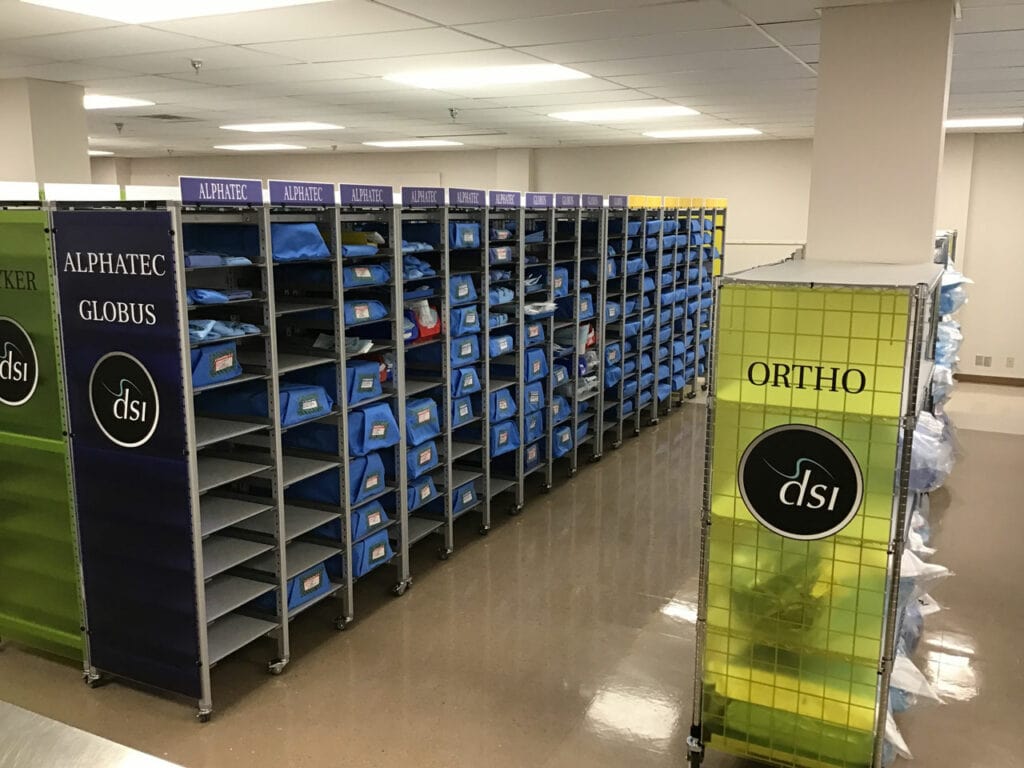
Maintaining a sterile environment is crucial for the safety and well-being of patients and staff in healthcare facilities. Proper storage of sterile instruments is a critical aspect of this, as it helps to prevent contamination and infection.
Let’s take a look at some key considerations for ensuring the safety of your employees and the integrity of your sterile products and devices through proper storage. By following these guidelines, you can protect your patients, staff, and facility from preventable dangers and ensure excellent patient care.
When it comes to safety, adequate lighting is a crucial consideration, especially when planning your sterile instrument storage. With good lighting, it is easier for your employees to see what they're doing and identify any potential hazards. This reduces the risk of accidents and injuries in the workplace. The right lighting can also help prevent workers from getting tired or strained eyesight by reducing the glare on screens and instruments.
For these reasons, you must consider the type of light fixture best for your facility. Ideally, you'll want a combination of natural light and artificial light. Natural light can help increase visibility during daylight hours. Artificial light helps keep workers alert during later shifts.
It's important to give employees ample space to move around and access instruments safely. You can't expect your employees to work in a cramped space and still be able to perform their tasks with the kind of care and precision you want them to have.
To provide this space, you need to make sure that there is plenty of room between the instruments. Therefore, they don't get damaged by being too close together or rubbing against each other. For example, if you're working with a microscope or other device that requires the use of both hands, then you'll need plenty of room around it.
You also need to ensure that there are no obstructions in the way of your workers' movements. Obstructions like shelves or cabinets could get in the way of reaching out for an instrument or taking it back from its place on a shelf.
Proper ventilation is essential for the storage of sterile instruments. The buildup and exposure to hazardous gases or fumes can cause several problems, including respiratory damage, fires, and explosions. Ventilation systems reduce the risk that these gases will build up as well as eliminate other contaminants from entering your sterile instrument storage area.
This can be achieved by installing a ceiling exhaust fan connected to the HVAC system or using freestanding fans. You can also use air purifiers to remove harmful vapors or gases from the air released into the room during sterilization.
Using personal protective equipment is essential for employee protection who are likely to be exposed to contaminants during their work. Infection control precautions are critical when planning for sterile instrument storage. This type of work may involve handling material that could be contaminated with a pathogen or other dangerous substance.
When working in a sterile environment, employees must wear protective clothing such as gloves, face masks, and respirators. These items help prevent pathogens from entering your body through cuts or open sores on your skin. They also help protect you from inhaling any particles in the air that may be harmful.
Proper sterilization and decontamination of instruments help to eliminate any potentially harmful microorganisms and chemicals that may be present, reducing the risk of infection and contamination.
It is important to follow established guidelines and protocols for sterilization and decontamination to ensure efficiency and safety. Proper training of healthcare professionals in these procedures is also essential to ensure that they are conducted correctly and consistently.
Proper training of employees on the ideal handling and storage of sterile instruments is essential to maintaining a safe and effective healthcare facility. When staff is knowledgeable about the proper handling and storage procedures, they are less likely to make errors that could potentially lead to contamination or the spread of infection. With medical carts, you can ensure the safety and accessibility of needed tools and supplies.
This, in turn, helps to protect patients and employees from harm. Proper training should cover topics such as the importance of maintaining the sterility of the instruments, the correct handling and storage procedures, and the proper use of personal protective equipment.
Conducting regular risk assessments is an essential aspect of maintaining a safe and effective healthcare facility. Risk assessments involve identifying potential hazards and implementing measures to mitigate or eliminate those risks.
With sterile instrument storage, regular risk assessments can help identify potential issues such as inadequate storage facilities, improper handling or storage procedures, and inadequate staff training.
By identifying these hazards and implementing appropriate safety measures, you can help ensure the safety of your employees. Some examples of safety measures that may be implemented as a result of a risk assessment include upgrading storage facilities, implementing new handling and storage procedures, and providing additional staff training.
When instruments are no longer usable or damaged, it is important to dispose of them while minimizing the risk of contamination and spreading infection. This may involve following established protocols for sterilization and disposal, as well as proper handling and storage of the instruments until they can be safely disposed of.
Proper disposal of used or damaged sterile instruments also helps protect the integrity of the facility's instrument inventory and prevent errors or accidents that could potentially harm patients or staff. Implementing policies and procedures for the proper disposal of these instruments is an important step in ensuring the safety of your facility and its occupants.
Above all these measures, proper storage of sterile instruments is essential in maintaining a safe and effective healthcare facility. By following these best practices, you can protect your employees and patients from contamination and the spread of infection, while also preserving the integrity of your instruments.
At DSI Direct, we understand the importance of employee safety and offer a wide range of high-quality sterile instrument storage solutions to meet your specific needs. Get in touch with us today to learn more about our smart storage solutions!

With 21 years of sales management, marketing, P&L responsibility, business development, national account, and channel management responsibilities under his belt, Ian has established himself as a high achiever across multiple business functions. Ian was part of a small team who started a new business unit for Stanley Black & Decker in Asia from Y10’ to Y14’. He lived in Shanghai, China for two years, then continued to commercialize and scale the business throughout the Asia Pacific and Middle East regions for another two years (4 years of International experience). Ian played college football at the University of Colorado from 96’ to 00’. His core skills sets include; drive, strong work ethic, team player, a builder mentality with high energy, motivator with the passion, purpose, and a track record to prove it.